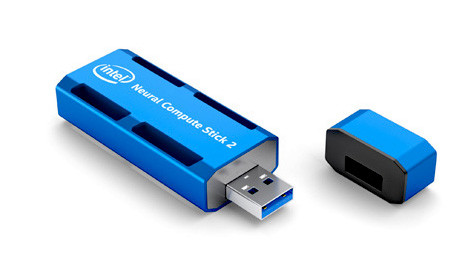Intel's Neural Compute Stick 2
November 29, 2018
on
on

Intel showcased their new Neural Compute Stick 2 (NCS2) at the Intel AI Devcon in Beijing last week. The stick plugs into a USB 3.0 port and provides accelerated computer vision processing and AI capabilities for edge devices in IoT and other networked applications.
The NCS2 facilitates the development of powerful AI algorithms in network-edge computer vision applications without reliance on cloud resources. The stick hardware is based on the Movidius Myriad X VPU (Vision Processing Unit) and is supported by the OpenVINO Toolkit, allowing speedy development of neural networks at low cost. The NCS 2 enables testing, tuning and prototyping of neural networks, allowing simple porting of the design to other form-factor systems for production.
According to Intel, the small USB peripheral brain also supports Computer vision and AI in the field of IoT applications. For projects using intelligent cameras, drones, industrial robots or other intelligent devices the Intel NCS 2 offers a powerful processing accelerator tool. The NCS2 is powered by Intel's latest VPU - the Movidius Myriad X VPU and supported by the OpenVINO toolkit, NCS 2 giving designers more flexibility to develop application prototypes.
All that’s needed is a USB3.0-capable PC or laptop and the NCS 2, for designers to start developing AI and image processing applications. Applications and tests can be run without Internet or cloud connectivity. The first generation NCS was launched back in 2017 and already has a community of tens of thousands of developers. This stick has already been featured in more than 700 developer videos and used in dozens of research papers. With the significantly increased performance of the NCS 2, the AI community will be able to develop even more demanding applications.
The NCS2 facilitates the development of powerful AI algorithms in network-edge computer vision applications without reliance on cloud resources. The stick hardware is based on the Movidius Myriad X VPU (Vision Processing Unit) and is supported by the OpenVINO Toolkit, allowing speedy development of neural networks at low cost. The NCS 2 enables testing, tuning and prototyping of neural networks, allowing simple porting of the design to other form-factor systems for production.
According to Intel, the small USB peripheral brain also supports Computer vision and AI in the field of IoT applications. For projects using intelligent cameras, drones, industrial robots or other intelligent devices the Intel NCS 2 offers a powerful processing accelerator tool. The NCS2 is powered by Intel's latest VPU - the Movidius Myriad X VPU and supported by the OpenVINO toolkit, NCS 2 giving designers more flexibility to develop application prototypes.
All that’s needed is a USB3.0-capable PC or laptop and the NCS 2, for designers to start developing AI and image processing applications. Applications and tests can be run without Internet or cloud connectivity. The first generation NCS was launched back in 2017 and already has a community of tens of thousands of developers. This stick has already been featured in more than 700 developer videos and used in dozens of research papers. With the significantly increased performance of the NCS 2, the AI community will be able to develop even more demanding applications.
Read full article
Hide full article


Discussion (0 comments)